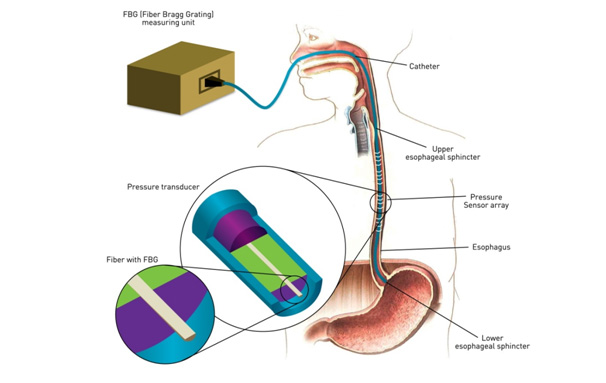

When you swallow, muscles in your oesophagus contract to help push food towards your stomach. Valves, or sphincters, inside the oesophagus open to let food and liquid through, and then close to prevent food, fluids, and gastric acid from moving backward. The sphincter at the bottom of the oesophagus is called the lower oesophageal sphincter or LES.
The purpose of oesophageal manometry is to see if the oesophagus is contracting and relaxing properly.

During oesophageal manometry, a thin, pressure-sensitive tube is passed through your mouth or nose and into your stomach. Once in place, the tube is pulled slowly back into your oesophagus. When the tube is in your oesophagus, you will be asked to swallow. The pressure of the muscle contractions will be measured along several sections of the tube.
A thin tube is passed through your nose or mouth to your stomach. Then it is pulled back into your oesophagus. The tube is attached to a monitor that measures the level of acidity in your oesophagus. You will wear this monitor on a strap and will be asked to keep a diary of your symptoms and activity over the next 24 hours. The next day you will return and the tube will be removed. The information from the monitor will be compared with the diary notes you provide.
It is a test performed to evaluate patients with constipation or fecal incontinence. This test measures the pressures of the anal sphincter muscles, the sensation in the rectum, and the neural reflexes that are needed for normal bowel movements.
The patient lies on his or her left side. A small, flexible tube, about the size of a thermometer, with a balloon at the end is inserted into the rectum. The catheter is connected to a machine that measures the pressure. During the test, the small balloon attached to the catheter may be inflated in the rectum to assess the normal reflex pathways. The nurse or technician may also ask the person to squeeze, relax, and push at various times. The anal sphincter muscle pressures are measured during each of these maneuvers. To squeeze, the patient tightens the sphincter muscles as if trying to prevent anything from coming out. To push or bear down, the patient strains down as if trying to have a bowel movement.
It measures how strong the sphincter muscles are and whether they relax as they are supposed to while passing a stool. It provides helpful information to the doctor in treating patients with fecal incontinence or severe constipation.